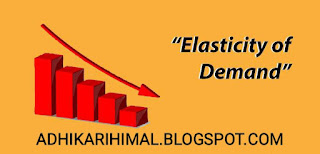Types of Income Elasticity of Demand
There are basically three types of Income Elasticity of Demand. They are:
I) Positive Income Elasticity of Demand
II) Negative Income Elasticity of Demand
III) Zero Income Elasticity of Demand
I) Positive Income Elasticity of Demand(EY>0)
The increase in income of the consumer lead to the increase in quantity demanded for a commodity and vice versa, it is called positive income elasticity of demand. This holds true for normal goods. In this case, the demand curve will be upward slopping. There are three types of positive income elasticity of demand. They are;
a) Relatively Elastic Demand ( Ey >1 ):
When the percentage change in quantity demand is greater than the percentage change in income of the consumer, it is said to be relatively elastic demand. It means that the rise in quantity demanded for a commodity is in greater proportion due to the proportionale rise in income and vice versa. This holds true for luxury goods. Thus,
When %∆Qd>%∆Y ,then EY>1.
In this case, the demand curve will be flatter as shown in the figure below:
In the above figure, quantity demanded increases from Q1 to Q2 with the increase in income from Y1 to Y2, in such a way that: Q1Q2 > Y1Y2. So that, EY>1 .
b) Relatively Inelastic Demand(EY<1) :
When the percentage change in quantity demanded for a commodity is less than percentage change in income of the consumer, it is said to be inelastic demand. This holds true for necessity goods. Thus,
When %∆Qd<%∆Y ,then EY<1.
In this case, the demand curve will be steeper as shown in the figure below:
In the above figure, quantity demand increases from Q1 to 02 to with the rise in income of the consumer from Y1 to Y2 in such a way that:
Q1Q2 <Y1Y2. So that, EY<1 .
c) Unitary Elastic Demand (EY=1):
When the percentage change in quantity demanded for a commodity is equal to the percentage change in the income of the consumer, it is said to be unitary elastic demand. This is known as happy accident case in economics . Thus,
When %∆Qd=%∆Y ,then EY=1.
In this case, the demand curve will be neither flatter nor stepper as shown in the figure below:
In the above figure, quantity demanded decreases from Q2 to Q1 with the increase in prite income from Y1 to Y2. This shows the inverse relationship between quantity demand and income of the consumer.
II) Negative Income Elasticity of Demand (EY<0 ):
The increase in income of the consumer leads to the decrease in quantity demanded for a commodity and vice versa, it is called negative income elasticity of demand. This holds true for inferior goods. In this case the demand curve will be downward slopping as shown in the figure below:
In the above figure, quantity demanded decreases from Q2 to Q1 with the rise in income from Y1 to Y2. This shows the inverse relationship between quantity demanded and income of the consumer.
III) Zero Income Elasticity of Demand (EY=0 ):
The percentage change in income of the consumer leads to no any change in quantity demand for a commodity, it is called zero income elasticity of demand, i.e. whatever be the level of income, the quantity demand for the commodity remains unchanged. Thus,
If %∆Qd=0 then, Ey=0.
This holds true for neutral goods like salt, medicine,etc.
In this case the demand curve will be vertical as shown in the figure below :
In the above figure , when the income of the consumer increases from Y1 to Y2, quantity demand for the commodity remains same as Q1.






